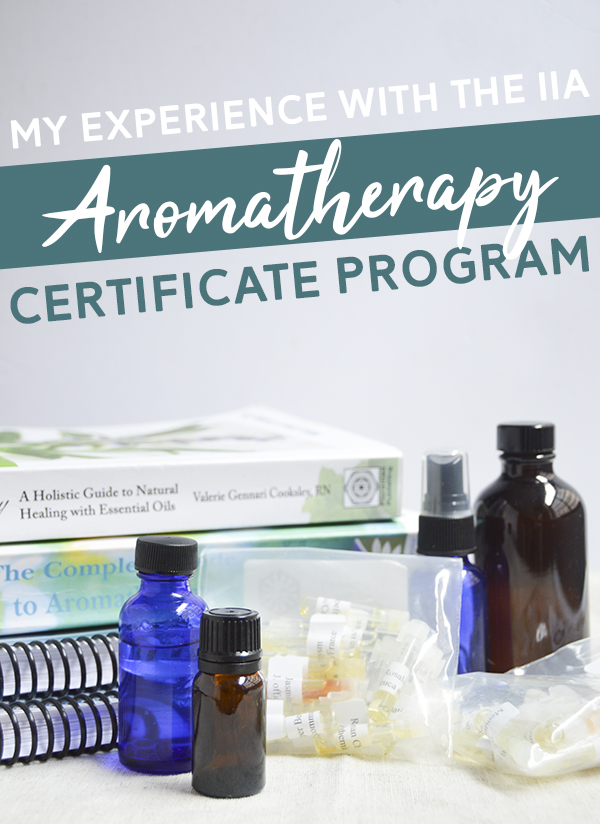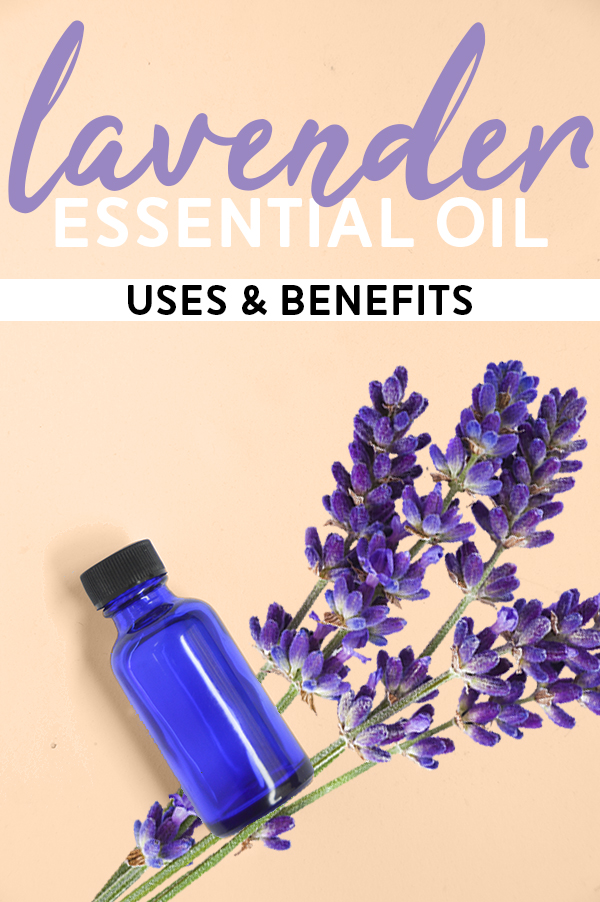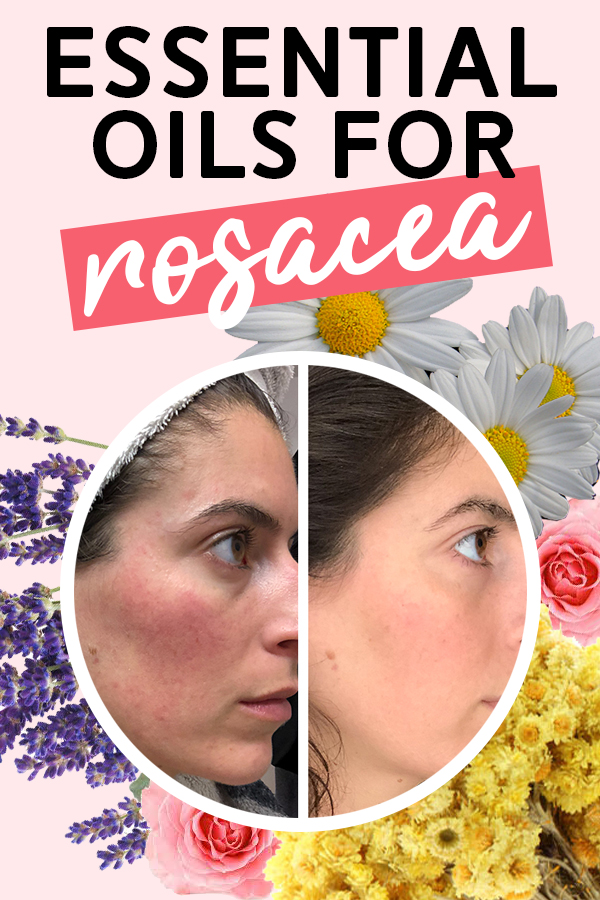
I’m so excited to share this blog post series with you! Rosacea is something I was personally struggling with prior to beginning my aromatherapy certification course, so when it came time to do case studies as part of my graduation requirements, I knew I wanted to dive deep into the issue. Over the next few days, I’m going to share everything I’ve learned about aromatherapy and essential oils for rosacea with you. I’ll also share the exact blends I’ve been using and show you how to make your own at home.
My skin has improved a ton, which is why I’m so pumped to share this all with you. That being said, we’re all different and what works for me may not work for you. I’m a Certified Aromatherapist—not a dermatologist or a doctor—so while I 100% stand behind aromatherapy as a complementary therapy, the advice I share here shouldn’t replace that of a medical professional.
What Is Rosacea?
The following is taken from the rosacea case study and intervention guidelines from my aromatherapy course. I’ve edited it a little to be more conversational. Sources are sited at the bottom of this blog post.
Rosacea is a chronic inflammatory skin disease characterized by flushing, fibrosis, redness, broken capillaries and dryness. Skin affected by rosacea can be couperose with the additional presence of acne-like papules. “Couperose” is redness due to the presence of dilated red blood vessels, so you get the appearance of tiny red spider-like veins on the surface of the skin. This can be accompanied by an irritating, tight, tingling, burning feeling. Rosacea typically affects the cheeks and nose but can affect other areas of the face as well.
There are four major subtypes of rosacea:
- Erythematotelangiectatic rosacea
- Papulopustular rosacea
- Phymatous rosacea
- Ocular rosacea
Rosacea is primarily caused by poor elasticity in capillary walls. When body temperature increases or blood rushes to the face, capillary walls expand. If they aren’t sufficiently elastic, they won’t, however, properly contract again to their original shape or size. This results in distended capillary that hold blood cells and give the appearance of redness on the face. This skin condition is aggravated by digestive disorders, poor nutrition and nervous disorders (Battaglia).
Rosacea involves several different regulatory systems (immune, nervous, vascular) and often affects multiple family members, suggesting a genetic component as well. Rosacea is most prevalent among middle-aged women, with the onset occurring most often between ages 30-60 or after menopause. It’s common in people with delicate, thin skin where the weakening capillary walls to the blood vessels in the face become easily visible (Steinhoff).
Factors that can trigger or exacerbate rosacea symptoms:
- Sun exposure
- Extreme hot/cold weather or rapid change in temperature
- Stress
- Consumption of spicy foods
- Intense exercise
- Alcohol
- Tobacco
My Experience with Rosacea
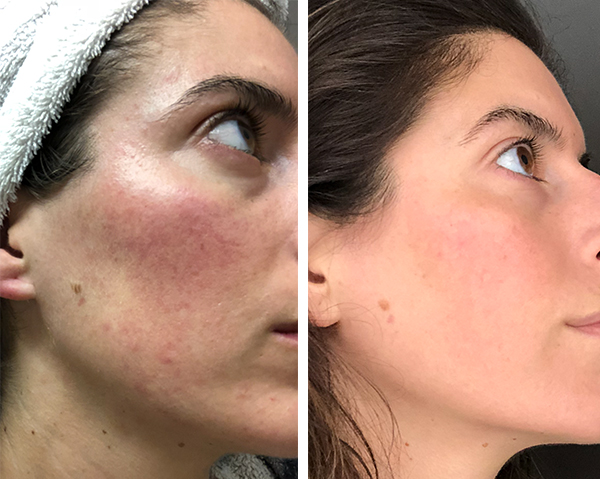
If you don’t care about my personal experience with rosacea and just want to find out more about helping your own situation, I totally understand and suggest you scroll passed this section. 😉
A couple years ago, I had what I thought was an allergic reaction to wine. My cheeks weren’t just flushed—they were bright red and felt tight, tingly and itchy. The next morning, they were better but I was left with tiny red marks that looked a bit like zits. I brushed off the incident, thinking I’d just stop drinking that brand of wine.
But then this redness issue started happening more frequently, and completely unrelated to drinking wine. If I did an intense workout, took a hot shower, or even was just experiencing anxiety, my face would flare up. And the redness wouldn’t go away. It almost looked like I had a breakout, with tiny splotches that looked like blemishes and others that looked like broken blood vessels. This got worse and more frequent over the year.
Even when I wasn’t having a flare-up, you could see the spots and small red blotches, almost like healing acne scars:
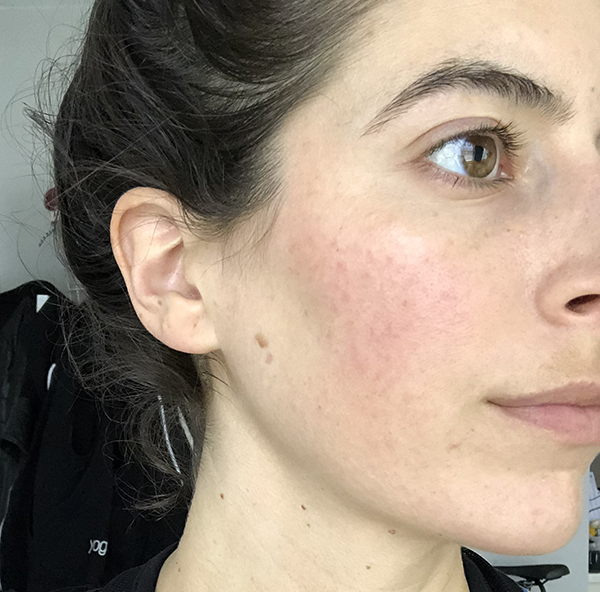
I’ve never had sensitive skin until now. It’s super oily, so while I struggled with breakouts in high school and college, I never had issues with redness, irritation or sensitivity. Because of this, I kinda just assumed the issue would correct itself. But I was getting increasingly self-conscious about my complexion. To make matters worse, these flare-ups (which were often triggered by anxiety), would make me feel even more anxious and insecure, so the redness would just get worse and deeper. Finally this motivated me to do some research.
All signs pointed to rosacea. (Two estethitians and an RN also agreed with my self-diagnosis, so this isn’t coming from Dr. Google.)
If I were to re-list all the rosacea symptoms and triggers I outlined in the previous section of this post, it’d be like check, check, yup, yes, got that, that’s me, shit—check.
It also makes sense to me because rosacea is caused by poor elasticity of the capillary walls, and when it comes to the circulatory system in general, I’ve always had minor issues. Nothing serious (so grateful for my general good health!), but I have Raynaud’s, which is a narrowing of the small arteries that reduces blood flow to the extremities. It’s triggered by cold temperatures and sometimes stress. Also, every time I’ve had to get blood drawn by a doctor, they always have difficulty and joke with me how tiny my veins are. I have many talents, but circulating blood efficiently throughout my body is apparently just not one of them.
This is a little aside, but pertinent: A while back, I wrote about my decision to stop drinking coffee. At the time I wrote that post, I didn’t have the full picture of what effect caffeine was having on my body. But in the years since quitting, I have now noticed that my threshold for what triggers a Raynaud’s episode seems a lot higher. I don’t seem to be as sensitive to the cold. I had already stopped drinking coffee when the onset of my rosacea began, but I have a strong feeling it would make it worse if I were to start drinking it again. Just wanted to highlight for anyone dealing with Raynaud’s and/or rosacea: Try ditching the caffeine (and/or other stimulants you might be taking). It’s been a game-changer for me.
I was knee-deep in my aromatherapy course when I realized I most likely had rosacea, so the first steps I made in treating it were to research, research, research and develop essential oil blends. I made a facial oil, a toner and a cooling misting spray, all of which I use regularly or daily. More on those below!
As with anything, the most effective treatment is one that takes into consideration not just the symptoms, but the cause. Essential oils are great and I absolutely love my skin care routine, but that’ll only get you so far. There are lifestyle changes, dietary considerations and other holistic interventions that are important, too. I’ll go into these in detail below, but the big things for me have been avoiding extreme temperature and caffeine, and managing anxiety.
I still have some redness issues with my skin and am working to improve that and my overall complexion, but in general—SO MUCH BETTER. The rosacea before-and-after pics in this post speak for themselves. That being said, before-and-after shots can be a bit misleading, and while I took these pictures in the same area of my apartment in front of the window, clearly there was better lighting the day I took the “after” shots. Still, the improvement is drastic, even without the help of good lighting!
Really the only time I feel like I have a rosacea flare-up is when I experience nervous anxiety. It’s usually in a good way—like before public speaking or in anticipation of something really exciting. The thing with these flare-ups is they don’t just go away when the anxiety subsides. They leave redness, irritation, and a rash-like appearance across my cheeks for hours, days or even weeks. My essential oil routine definitely helps with the duration and intensity, but my next step will be to look into how I can use aromatherapy to help calm this nervous anxiety to nip the situation in the bud. I’ll of course keep you all posted!
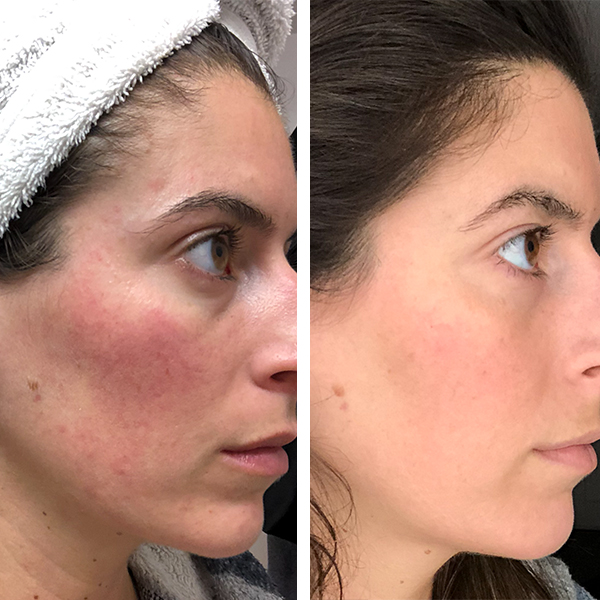
Main takeaways from my experience:
- Your skin changes as you get older. What worked for you in your 20s might not work for you in your 30s/40s/etc.
- Extremes don’t work well (for me). Extreme heat (or cold for my Raynaud’s), extremely intense workouts, extreme stress/anxiety, extremely spicy foods, extreme caffeination—no bueno. Finding balance and moderation makes for calm skin.
- Simple skincare is best (for me). Everyone is different, but I’d encourage people with any sort of skin sensitivity or redness to simplify their skincare routine. Minimal, thoughtfully-selected ingredients have made my skin the happiest.
- Lasting change takes time—be patient! This is important to keep in mind as you read the rest of this blog post where I share specific aromatic blends for rosacea. Real improvement in my skin took close to a *year*. For reference, the “before” pics are from April 2018 and the “afters” are from February 2019. I noticed reduction in severity of flare-ups pretty quickly, but for real change I had to be patient and stick with it.
Essential Oils for Rosacea — How Aromatherapy Can Help
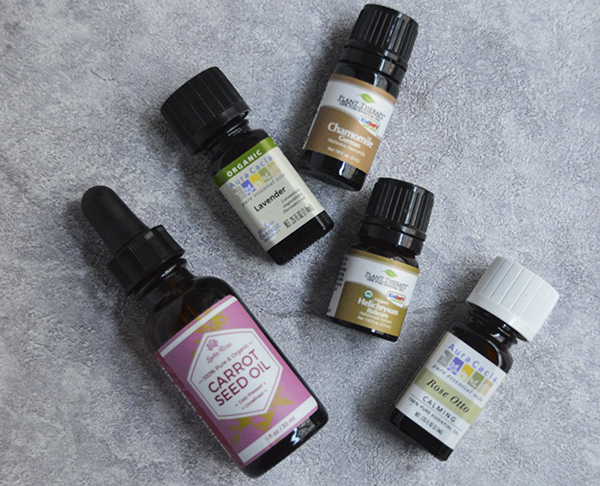
I’m going to start general and then get specific with recommendations and the blend recipes that I personally use.
Essential Oils for Rosacea
Links in this section are mostly to Plant Therapy, a brand I personally use and love. For other brands I’d recommend, check out this post. Below links are affiliate.
If you’re looking at the below list thinking it seems long, that’s because everyone’s skin is different. It’s important to list all the options for rosacea so that you can find a combination of oils that works for you.
In general, what these oils all have in common is that they’re gentle (great for not just rosacea but any sensitive skin!) and have anti-inflammatory properties. If you’re going to make a blend for yourself, I’d highly recommend incorporating one of the first three listed below (German chamomile, Helichrysum and/or Rose otto).
- German chamomile (via Amazon) – One of the gentlest essential oils, making it great for treating sensitive skin issues. Anti-inflammatory, anti-allergenic and supports calmness.
- Helichrysum (via Amazon) – Great for sensitive skin and inflammation, broken veins, couperose skin and old scars.
- Rose otto (via Amazon) – Ideal for skin care, especially sensitive, mature and/or dry skin. Indicated for broken capillaries and poor circulation. This essential oil is pricey. I love it, but if you’re trying to keep the cost of your blend down, I’d use Helichrysum and/or German chamomile instead.
- Lavender (via Amazon) – Another gentle oil that’s safe for almost all skin types. Good for skin inflammations, and calming for both skin and emotions. You can read more about Lavender essential oil in the linked blog post.
- Neroli (via Amazon) – Tones the skin and is good for sensitive skin; also a circulatory tonic.
- Sandalwood (via Amazon) – Relieves itching and inflammation, can be helpful in calming a rosacea flare-up.
- Carrot seed (via Amazon) – Good for irritated skin. A depurative, which are used in the treatment of chronic inflammatory diseases. Carrot seed is an essential oil but is most often used as part of a carrier. Don’t use undiluted on the skin.
- Jasmine (via Amazon) – Good for dry and/or sensitive skin. Jasmine is also used to support anxiety, so if your rosacea is triggered by anxiety it can be helpful.
Anti-inflammatory essential oils are beneficial for soothing and reducing the inflamed, flushed skin. A 2018 study applied moisturizer with anti-inflammatory and antioxidant botanicals to just half of 30 subjects’ faces affected by chronic redness. The half treated with these botanicals showed a statistically significant improvement in scaling, flaking, smoothness, firmness and overall appearance of redness (Draelos).
One note: With papulopustular rosacea, sufferers have a higher density of Demodex folliculorum mites on their faces. These bacterium have the potential to stimulate the inflammatory rosacea response (Lacey). If you have this particular type of rosacea, essential oils with antibacterial and antimicrobial properties (as well as anti-inflammatory) are going to be most useful in treatment. From the above list, Lavender and Neroli would be good options (especially Lavender).
Carrier Oils for Rosacea
Carrier oils are the vegetable oils in which you dilute essential oils before applying to your skin.
- Jojoba (via Amazon) – Good for inflammation and all skin types. Jojoba oil is actually a liquid wax and is similar to the sebum our own body produces, making it ideal for skin care.
- Tamanu (via Amazon) – Has anti-inflammatory and anti-oxidant properties; used in healing damaged skin and rashes.
- Apricot kernel (via Amazon) – A fine, light seed oil that helps with healing and rejuvenating skin cells. Used frequently in facial preparations and is great for delicate, inflamed and/or sensitive skin.
- Borage seed (via Amazon) – High in GLA (gamma linoleic acid), which is an anti-inflammatory and important for healthy skin. Recommended to used in 10% dilution.
- Hazelnut (via Amazon) – Useful in facial oil blends because it’s easily absorbed and good for all skin types. It’s rich in vitamins, minerals and protein.
- Avocado (via Amazon) – Great for aging, dry and/or undernourished skin. It’s rich and heavy, and good for all skin types. Short shelf life so store in the refrigerator and buy it in small quantities.
- Safflower (via Amazon) – Good for all skin types and helps soften the skin. Has a light-medium consistency and is pretty odorless if you’re sensitive to scents.
- Sesame oil (via Amazon) – A lightweight oil rich in Vitamin E, minerals, protein and lecithin that can speed healing and prevent drying. Not to be confused with the toasted sesame oil you find in the grocery store.
Specific Aromatherapy Blends for Rosacea
This section includes specific aromatherapy blends for rosacea and links out to the exact recipes I personally use.
Daily Facial Oil
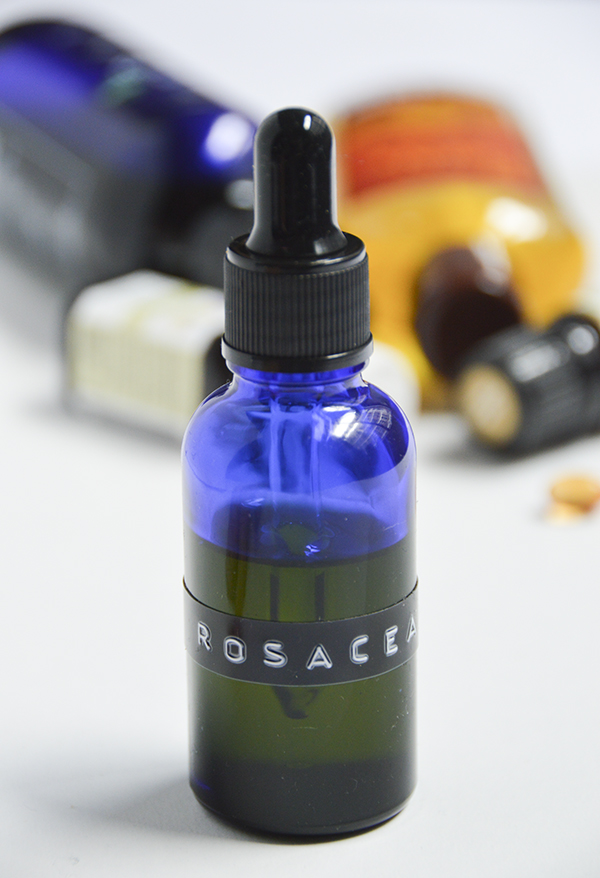
For the exact blend recipe I personally use, check out My Facial Oil for Rosacea.
With any type of sensitive, inflamed skin, it’s best to avoid complex blends of essential oils. There may be several oils and carriers on the above lists that sound perfect for you, but try to keep your blends simple. 1-2 carriers, 2-3 essential oils max. Start there and then if you want to try incorporating others into the blend, you can.
Facial oils should be applied to moist skin after cleansing and toning, by putting a couple drops on fingertips and gently smoothing/patting on in an upward motion.
Here’s a general guideline to make a facial oil blend for rosacea. Use the lists above to select essential oils and carriers.
- 1 oz (= 2 tbsp) carrier oil(s)
- 12 drops essential oil(s)
- 400 IU Vitamin E
I recommend adding an antioxidant like Vitamin E to facial oil blends because it’ll prolong the shelf life—plus Vitamin E is great for skin. You can buy a bottle of Vitamin E gels where ever you buy supplements and simply rip open the gel casing and squeeze it out into your blend.
The above recipe guidelines will make 1 oz of facial oil at a 2% dilution. For really sensitive skin, you may want to reduce the number of drops of essential oils further so it’s more like a 1-1.5% dilution. However, the oils recommended are gentle and specifically suited to sensitive skin, so I wouldn’t anticipate problems at 2%.
Add your carriers and antioxidant then the essential oils, and shake to combine. It’s always smart to do a skin patch test of essential oils to make sure you don’t have an allergy or sensitization to them before using in a blend. More on essential oil safety in this post.
Daily Hydrosol (Floral Water) Toner
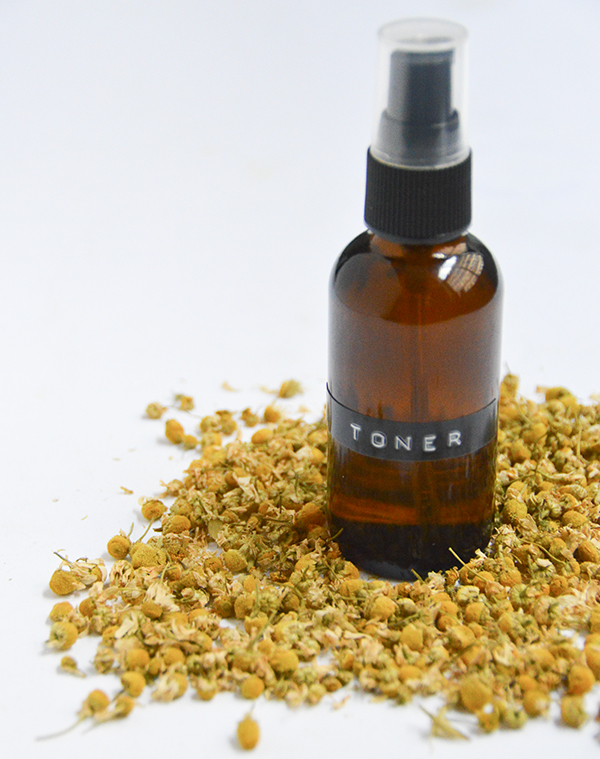
The goal of a toner is to balance the skin’s pH and provide moisture. You should apply it daily after cleansing and before a facial oil. Safe, gentle, alcohol-free toners can be hard to find, so it’s best to use a simple floral water and add some apple cider vinegar if you have rosacea or general sensitive, easily-irritated skin. Chamomile, orange blossom and lavender floral water are the most gentle options.
I personally use a German Chamomile hydrosol toner with apple cider vinegar. Read more about it and learn how to make it yourself at home here: DIY Chamomile Floral Water Toner. And if you’re looking for a ready-to-use product, I’d recommend the brand Hello Cider (organic and available via Amazon Prime).
Cooling Mist for Flare-Ups
During a flare-up, when the heat is rushing to the face, a cooling toner or facial mist can be beneficial. Peppermint is a great cooling oil, but should be used in very low dilution with aloe vera and distilled water for a facial mist.
Read all about the blend I use and other options in this post about cooling mists for rosacea flare ups.
Aromatherapy for the Bigger Picture
With holistic aromatherapy, you want to treat the issue and the symptoms, but also take a step back and look at the bigger picture. What’s triggering the symptoms? What emotional distress are the symptoms causing? What other issues are there in the person’s life that may contribute to the symptoms?
If, for example, stress and anxiety are a trigger for your rosacea flare-ups, aromatherapy for these emotional issues could be beneficial. Diffusing an anti-anxiety blend during stressful times could reduce these feelings and therefore prevent a rosacea flare-up.
I can’t speak for everyone with the condition, but I know I was feeling insecure about the appearance of my skin and really down when my rosacea was at its worse. There are essential oils with uplifting, anti-depressant effects that can be beneficial for these emotions as well.
Other Holistic Interventions for Rosacea
Using essential oils for rosacea without making any lifestyle changes to go along with it is like eating a healthy breakfast while continuing to eat processed junk the rest of the day. It helps, and it’s certainly a step in the right direction—but for lasting, significant change, you gotta go deeper.
Lifestyle Changes
Avoid extreme hot or cold temperatures, saunas, sun exposure, smoking, alcohol, caffeine, and intense exercise that causes the face to turn red. Emotional stress can be a trigger as well so prioritize self-care and stress management (yoga, meditation, diffusing an essential oil blend for stress, etc.).
From the above, it’s really just intense exercise, sun exposure and alcohol that I’m guilty of enjoying. I use a cooling mist spray after intense exercise that seems to help, and it’s really only in the summer when I get so overheated from a workout that my rosacea flares up. As for sun exposure, I started wearing a hat at the beach this past summer which helps. I do still drink alcohol but not even weekly—and I find if I stick to beer, my skin is fine.
I also wash my face with cool water now. Living in Boston, there’s just no way in hell I’m taking a cold shower in the winter. So I’ll save the cold face washing for after my shower at the sink. This has seemed to help!
Dietary Changes
Avoid drinking hot liquids and eating spicy foods. Foods that cause inflammation can be a potential trigger, so eliminating dairy, gluten and foods in the nightshade family (whaddup Tom Brady) can be helpful for some.
I don’t eat dairy or enjoy hot liquids, but I love spicy food and eat gluten regularly. I’ve turned down the intensity of the hotness of the spicy food I eat, just to be safe. I don’t have any sensitivities to gluten, and have never noticed an adverse reaction to it. I personally would only try eliminating it if my rosacea came back and stayed around and it was my last resort. That being said, if you have a sensitivity to gluten, it could be exacerbating your rosacea, and it’s worthwhile to look into that possible connection.
Products to Avoid
Products to avoid if you have rosacea are similar to those anyone with sensitive, easily irritated skin should look out for:
- Harsh scrubs and alcohol-based toners
- Artificially fragranced soaps, makeup, moisturizers, detergents, etc.
- Synthetic fragrance or perfume
- Chemical preservatives
- Petroleum or lanolin byproduct
- Coconut, cocoa butter and corn oils can also be sensitizing (Cooksley)
—————————
I know this blog post was long, but I really want it to be as comprehensive as possible. My goal is for it to be your go-to guide to essential oils for rosacea.
Keep in mind that everyone is different, and aromatherapy is most successful when done with the individual in mind. The oils and blends that work amazingly for me may not have the same results for you, for a variety of reasons.
My goal in sharing all this information is to give you a guidelines, upon which you can build. Try different things, ask questions, and be patient as you figure out what works best for you.
And speaking of questions, leave them in the comments below! Sometimes I admittedly slack on responding to blog comments if the post is older, so you can also always send me a DM on Instagram (@nicolepearce)—I’m very responsive there!
xo Nicole
The statements and blends referenced in this post have not been evaluated by the Food and Drug Administration. Products and/or information are not intended to diagnose, treat, cure or prevent any disease. If you are pregnant, nursing, have a medical condition or are taking any medication, consult with your physician before using any essential oil or blend.
I’m a Certified Holistic Aromatherapist through the Institute of Integrative Aromatherapy and only share blends with you that I’ve personally used and from which I’ve benefited. I stand behind them 100%! That being said, essential oil blends are most effective when made with individual needs, goals and personality in mind.
Sources
Battaglia, Salvatore, The Complete Guide to Aromatherapy, The International Centre of Holistic Aromatherapy, 2003.
Cooksley, Valerie, R.N., Aromatherapy: A Holistic Guide to Natural Healing with Essential Oils, Floramed Publishing, 2015.
Draelos, Zoe and Donald, Angela, The Effect of an Anti-Inflammatory Botanical Cleanser/Night Mask Combination on Facial Redness Reduction, Journal of Drugs in Dermatology, Volume 17, Issue 6, 2018 (http://jddonline.com/articles/dermatology/S1545961618P0671X). Jan 25, 2018.
Lacey, N., Delaney, S., Kavanagh, K., Powell, F.C., Mite-related bacterial antigens stimulate inflammatory cells in rosacea, British Journal of Dermatology, 2007 (https://doi.org/10.1111/j.1365-2133.2007.08028.x). Jan 25, 2018.
Steinhoff, Martin et al. New insights into rosacea pathophysiology: A review of recent findings, Journal of the American Academy of Dermatology, Volume 69, Issue 6, 2013 (https://www.ncbi.nlm.nih.gov/pubmed/24229632). Jan 25, 2018.
Steinhoff, Martin et al. New insights into rosacea pathophysiology: A review of recent findings, Journal of the American Academy of Dermatology, Volume 69, Issue 6, 2013 (https://www.ncbi.nlm.nih.gov/pubmed/24229632). Jan 25, 2018.
